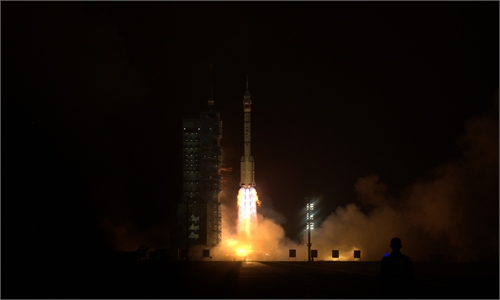China has made another historic stride in its deep space endeavors on Friday, as the Long March-5 Y8 carrier rocket blasted off at 5:27 pm from the Wenchang Space Launch Site in South China’s tropical island of Hainan, sending the Chang’e-6 lunar probe onto its odyssey in the world’s first ever attempt to bring back lunar samples from the far side of the Moon.
The China National Space Administration (CNSA) confirmed the success of the launch after two pairs of solar panels of the spacecraft opened smoothly.
The round trip of Chang'e-6 to the moon and back will take about 53 days, more than double the duration of its predecessor Chang’e-5, which returned samples from the near side of the moon in some 23 days, media reported.
The longer duration also indicates more complex flight stages – researchers have designed 11 stages for Chang’e-6, including launch and orbit insertion, lunar transfer, among others, media reported on Friday.
The amount of Moon samples to be returned this time is also expected to be larger than the Chang’e-5 mission. It is expected to retrieve around 2,000 grams of lunar dust and rocks, an increase of some 270 grams than the last time.
The Chang'e-6 mission aims to break new ground in lunar retrograde orbit design and control, intelligent sampling on the moon's far side, and ascent from the lunar surface, according to the CNSA. It will conduct an automated sample return from the moon's far side, along with scientific exploration of the landing area and international collaboration, the agency added.
After flying into orbit, it will head toward the Moon. Upon reaching its vicinity, the probe will brake to enter lunar orbit, and then fly around the orbit, during which time the lander and ascender combination will land on the far side of the moon, a research fellow with CASC revealed on Friday.
After completing the sampling, the ascender carrying the collected lunar soil will take off from the far side of the Moon to rendezvous and dock with the orbiter-returner combination, transfer the lunar samples to the returner, and then head back to Earth. It will re-enter the Earth’s atmosphere in a semi-ballistic skip manner and land in Siziwang Banner, North China’s Inner Mongolia Autonomous Region.
Chang'e-6 will adopt the same sampling methods used by Chang'e-5, utilizing drilling and scooping to obtain samples from different layers and depths of the lunar surface, simultaneously conducting scientific exploration on the lunar far side.
The location of the drilling is targeted at the Aitken Basin in the lunar south pole, a crater formed some 4 billion years ago and believed to contain water ice.
The Aitken Basin is one of the three major lunar landforms, and is the oldest and deepest impact crater basin on the moon, with significant scientific research value.
“This is of great significance for humans to have a more comprehensive understanding of the Moon, deepen the study of lunar origin and evolution, planetary evolution, and the origin of the solar system,” said Hu Zhenyu, the chief engineer of the launch site engineering technology group for the mission.
To promote international cooperation, the Chang’e-6 mission will carry a number of international payloads to the Moon, including the European Space Agency's lunar surface ion composition analyzer, France's radon detection instrument, Italy's laser corner reflector, and a CubeSat from Pakistan, the CNSA revealed to the Global Times.
The Chang'e-6 mission is part of the country’s Phase-4 lunar exploration program, which eyes landing taikonauts on the Moon before 2030.
China is also leading the International Lunar Research Station (ILRS) project together with Russia in the lunar south pole. The project will see a basic station built by 2035 and an expansion set for completion by 2045, with a moon-orbiting space station as the hub and facilities featuring complete functions.
So far, nearly 20 countries and organizations have joined the ILRS, including US Hawaii-based International Lunar Observatory Association, Swiss company Nano-SPACE for Cooperation, and France's Thales Group.
The mission comes amid increasing efforts by various countries to enhance their lunar programs, driven by a heightened interest in the opportunities for accessing resources and advancing deep space exploration.
Following Russia, the US and China, India successfully landed its first spacecraft on the Moon last year. And in January this year, Japan became the fifth member to join the lunar landing club, but its lander soon faced power issues due to incorrect landing angle.
The US is also pursuing its own schemes to return astronauts to the Moon as soon as 2026 and build a scientific base camp. However, the program, called Artemis, has been facing a number of challenges that put the scheduled date in question.
The Long March-5 carrier rocket, with a total length of nearly 60 meters and a takeoff mass of about 869 tons, is a true “giant” in China’s rocket family.
It is equipped with four boosters and has a payload capacity of 25 tons to low Earth orbit and 14 tons to geostationary transfer orbit, making it the largest launch vehicle in active service in China.
Since the Chang'e-6 probe is 100 kilograms heavier than Chang'e-5, designers have managed to help the rocket to "lose weight" and thus increasing Long March-5’s lunar transfer orbit payload capacity by 100 kilograms to meet the requirements of its “passenger,” the CASC revealed.
PETALING JAYA: Leftenan Muda Chan Ming Youn beat all the odds to achieve his aim to become a member of one of the world’s toughest military units – Gerup Gerak Khas or Special Service Group.
The 25-year-old from Setapak, who graduated from Tunku Abdul Rahman University of Management and Technology (TAR UMT), earned his “green beret” on Sunday after passing 12 weeks of harsh and gruelling training.
“My parents were deadset against me joining the military, otherwise I would have done so soon after my SPM. They wanted me to get a degree and a job related to what I studied.
“I had constant arguments with them when I insisted on joining the armed forces because it is my childhood dream.
“I want to serve and protect my country in the most noble way I know,” he said in an interview yesterday.
To appease his parents, Chan, who is the youngest of three siblings, took up accountancy at TAR UMT and obtained a bachelor’s degree. While studying for his degree, he signed up as a reservist with the Territorial Army Regiment to fulfil his yearning to be a serviceman.
As the longing grew with his stint as an army volunteer, he decided to apply to join the army as a cadet officer in 2022.
Upon passing the interview and undergoing regular army training for nine months, he was briefly posted to the 2nd Royal Ranger Regiment before he set his mind to enrol in February as a candidate in the commando unit, which is known through its Malay acronym GGK.
He was then put through the GGK’s basic training, an exercise that determines whether a candidate qualifies to make it as an elite member of the special forces before he is assigned to undergo other specialised skills in weaponry, parajumping and close-quarters combat to become a full-fledged commando.
Recounting his experience during his 12-week training stint at the Sungai Udang Army Camp in Melaka, Chan said it was the toughest moments he had ever undergone in his life despite his love for the military.
Soon after the exercise began, his body was in immense pain and aching all over and then riddled with blisters, bruises and torn skin.
He said the most difficult task he faced was a 160km run with other recruits that left the soles of his feet inflamed and torn.
“In the jungle, we were to survive on very little food, and went hungry. When we ran out of supplies, we had to feed ourselves with whatever we could find in the forest such as monitor lizards and pythons.
“It was beyond what I had ever imagined.
“The training will break you both mentally and physically but that is what it takes to be an elite member of the special forces and to make us resilient.
“I almost lost my mind and had thoughts of giving up halfway through the training but the comradeship of my fellow recruits and the constant support of my trainers kept me going.
“The camaraderie was amazing. We were united as a unit and there was no differentiating anyone by race.
“We were like brothers who watched over each other’s backs and ensured we stayed sane. This was the greatest thing I will never forget,” he said.
On Sunday, Chan received his green beret, blue lanyard and a dagger, which qualified him as commando, from 21st GGK commander Mejar-Jen Adi Ridzwan Abdullah in a graduation ceremony at the Sungai Udang camp.
Chan said his parents who were present were pleased to see him in good health.
“I know they are proud of me although all they asked me was if I had eaten and in good health. Those words were enough to affirm their support.
“During the tough training, my thoughts were also on my parents who had raised me and I just did not want to let them down.
“That too kept me motivated,” he said.
When contacted, Mejar-Jen Adi Ridzwan said Chan is the first Malaysian Chinese in decades to pass out as a commando.
“He had applied to undergo the tough training moreover, and was not assigned to it. This is very admirable and he proved himself very well.
“The last time we had Malaysian Chinese commandos was almost 20 years ago. There were many of them in the 1970s and 1980s.
“Hence, we are seeing a revival of Malaysian Chinese returning to serve the army like how their predecessors did.
“We are happy to see this and we hope more non-Malays will join the armed forces,” he said.












